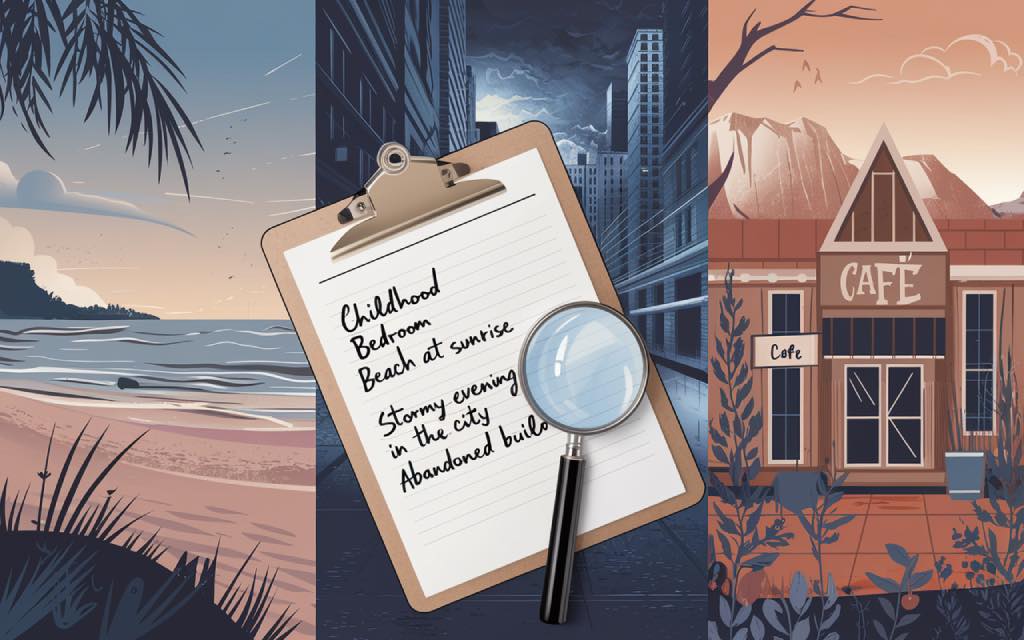- Descriptive writing uses vivid, sensory language to craft immersive and memorable narratives, transforming simple scenes into vivid experiences. It relies on key principles:
– Precision and clarity: Use purposeful language to enhance the story
– Sensory engagement: Appeal to sight, sound, touch, taste, and smell
– Balance: Avoid overwhelming details; align descriptions with the narrative
– Originality: Replace clichés with fresh imagery - Avoid pitfalls like overly ornate language, redundancy, or lack of sensory details, which can weaken prose.
- Effective techniques include “show, don’t tell,” varied sentence structures, and vivid language like similes and metaphors. Examples, such as describing a storm’s “inky skies pierced by lightning,” illustrate this approach.
- Advanced strategies, like juxtaposition or symbolism, enrich scenes further. Writers can also use the RAFT framework: define their role, tailor descriptions to the audience, structure thoughtfully, and align with the topic. Mastering these methods elevates descriptive writing into a powerful storytelling tool.
Descriptive writing serves as an essential tool in crafting vivid and engaging narratives, drawing readers into immersive and well-defined scenes. By employing techniques that stimulate the senses, this form of writing enhances storytelling methods on multiple levels. This article provides a comprehensive exploration of descriptive writing—its principles, methods, and examples—to help elevate your skills in creating more engaging and compelling works.
What is descriptive writing?
Descriptive writing is a writing style that uses vivid and precise language to bring scenes, characters, and emotions to life. By engaging the five senses—sight, sound, smell, taste, and touch—it creates vivid imagery that makes the narrative feel immediate and immersive. For example, a description of Tokyo’s neon signs might emphasize how their glow reflects on rain-slick sidewalks, shimmering like scattered stars. This approach enriches narratives with tangible details, ensuring even the simplest moments become memorable.
Why Descriptive Writing Matters

Descriptive writing has the power to transform even simple narratives into beautifully crafted works. By employing comparisons, metaphors, personification, and other literary devices, writers can create vivid images that resonate deeply. For example, describing a gentle breeze as “playful fingers weaving through the tall grass” can evoke a scene that feels alive and dynamic. This description is particularly effective in evoking the essence of travel or natural settings, making readers feel as if they are experiencing new places or relishing the beauty of a remote wilderness. By engaging the senses, descriptive writing ensures that stories remain immersive and memorable.
Principles of Descriptive Writing
Effective descriptive writing relies on a few key principles:
- Precision and clarity: Every word should serve a purpose. Avoid unnecessary embellishments and focus on descriptions that enhance the narrative.
- Sensory engagement: Use language that appeals to the senses. Descriptions of textures, sounds, or smells can create a vivid and lasting impression.
- Balance: While rich details are important, they should not overwhelm the narrative. Maintain a steady pace by ensuring descriptions serve the story rather than detract from it.
- Originality: Avoid clichés or overused phrases. Unique and fresh imagery keeps the writing dynamic and engaging.
Common Pitfalls in Descriptive Writing
Descriptive writing can falter when it becomes overly elaborate or lacks focus. Some common mistakes include:
- Overuse of flowery language: Overly ornate descriptions can obscure the narrative and feel artificial. Aim for language that is evocative yet grounded.
- Lack of sensory details: Neglecting sensory engagement can result in flat, uninspired prose. Ensure descriptions evoke a clear sense of place and emotion.
- Redundancy: Repeating the same ideas or using filler words can weaken the impact of the writing. Each sentence should contribute something meaningful.
By prioritizing precision and keeping descriptions aligned with the story’s purpose, writers can avoid these pitfalls and create impactful, memorable work.
Descriptive Writing Examples

Descriptive writing provides an opportunity to transform even the most mundane scenes into memorable experiences by focusing on precise details and imaginative language. This section offers diverse topics to spark your creativity and demonstrates the difference between ordinary and evocative descriptions through clear examples.
Topics for Descriptive Writing
- A walk through a forest in autumn
- A crowded market during the holidays
- The view from a mountain summit
- A bustling coffee shop on a rainy day
- A childhood bedroom
- A beach at sunrise
- A stormy evening in the city
- An abandoned building
- A summer carnival
- A snowy village during winter
Examples of Descriptive Paragraphs
| Flat and Ordinary | Improved with Descriptive Writing |
|---|---|
| The forest was nice. Trees were everywhere, and the air smelled good. | The forest was alive with golden leaves shimmering under the autumn sun. The earthy aroma of damp soil mingled with the crisp scent of pine, while the rustling leaves whispered secrets of the wind. |
| The coffee shop was busy. People were talking, and there was a coffee smell. | The coffee shop buzzed with energy as patrons chattered over steaming mugs. The rich, nutty aroma of freshly brewed coffee mingled with the faint sweetness of pastries, while rain tapped rhythmically against the windows. |
| The beach was beautiful. The waves were big, and the sand was soft. | The beach stretched out like a golden ribbon, its soft sands warm underfoot. Waves crashed with rhythmic power, their salty spray carried by the gentle sea breeze. |
| The storm was bad. It was dark and windy. | The storm raged with ferocity, its inky skies pierced by jagged streaks of lightning. Fierce winds howled through the trees, carrying the sharp scent of rain and the metallic tang of approaching thunder. |
| The carnival was fun. There were lights and rides. | The carnival dazzled under a kaleidoscope of twinkling lights. The air buzzed with the mingling sounds of cheerful laughter, the hum of rides in motion, and the sugary aroma of cotton candy drifting through the crowd. |
How to Write Descriptively

Descriptive writing relies on a variety of techniques to immerse the audience and bring scenes to life. Below are several strategies for refining your craft:
Using the “Show, Don’t Tell” Principle
Effective descriptive writing hinges on the principle of “show, don’t tell.” This means using vivid imagery and sensory details to create a scene, rather than relying on straightforward statements. For instance, instead of stating that “the cat was scared,” you might describe, “The cat’s heart raced, its fur bristled, and its eyes widened in alarm.” This approach allows the audience to visualize and feel the moment, leaving a more profound impression.
Using Sensory Details
Descriptive writing thrives on sensory engagement, allowing readers to vividly experience the scene. When describing a bustling city street, for example, you might evoke the neon lights reflecting in puddles, the blaring horns of traffic, the rough texture of the pavement, the aroma of sizzling street food, and the faint tang of dust in the air. These details work together to immerse the reader in the scene, making it tangible and memorable.
Choosing Vivid Language
Selecting precise, vivid language elevates descriptive writing. Replacing generic words with specific and dynamic ones makes descriptions more impactful. For instance, consider an oak tree not as just large but as “a massive oak with limbs stretching skyward like a grand cathedral.” This attention to detail enriches the narrative. Moreover, similes and metaphors are invaluable tools, offering fresh comparisons that amplify descriptive impact. Writers who experiment with varied word choices build a diverse vocabulary that ensures clarity and avoids superficiality.
Varying Sentence Structures
Sentence variety is crucial in maintaining rhythm and engagement. A mix of short, dynamic sentences and longer, flowing ones adds texture to the prose. Short sentences can create tension and urgency, while longer ones allow for richer, more detailed descriptions. For example, begin with a bold, attention-grabbing statement and follow it with a detailed, flowing sentence that dives deeper into the scene. This variation keeps the narrative dynamic and captivating.
Figures of Speech in Description
Figures of speech such as similes, metaphors, and personification enhance descriptions by adding depth and evocative clarity. A simile like “her hair was as black as midnight” creates a vivid visual image that lingers in the mind. These techniques not only clarify complex ideas but also bring a fresh and impactful quality to the prose. Their deliberate use ensures that every phrase serves the story’s purpose effectively.
Exploring New Techniques
Beyond the commonly discussed methods, descriptive writing can be enriched through:
- Dialogues and actions: Use character interactions or movements to reveal details about the setting or mood.
- Juxtaposition: Contrast elements within a scene to heighten its impact, such as a lone candle flickering in a vast, dark room.
- Symbolism: Incorporate objects or elements that carry deeper meanings, such as a blooming flower representing hope in an otherwise bleak setting.
- Dynamic perspectives: Describe scenes through the lens of different characters to introduce varied emotional tones and insights.
Structuring with Intent: The RAFT Strategy
The RAFT strategy provides a structured approach to descriptive writing:
- Role: Define the perspective or identity of the writer.
- Audience: Identify who the description is intended for and tailor language accordingly.
- Format: Decide the structure or style of the piece, whether it is a letter, narrative, or report.
- Topic: Focus on the subject matter to ensure all descriptions align with the central theme.
By focusing on these elements, writers can craft purposeful and polished descriptions, ensuring every detail serves the narrative effectively.
Further Reading
How to Write a Good Descriptive Paragraph by Richard Nordquist, ThoughtCo.
The Power of Descriptive Writing by JL Rothstein, jlrothstein.com
Excerpts of brilliant descriptive writing on writingforums.org
Description: The Good the Bad and the Just Please STOP by Kristen Lamb, authorkristenlamb.com




